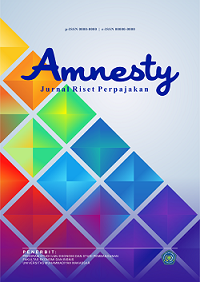Tax Planning Strategies for Tax Saving at PT Ramayana Lestari Sentosa, Tbk
DOI: https://doi.org/10.26618/jrp.v8i1.17045
Tax Planning, Tax Saving, Income Tax Expense, Tax Payable
Abstract
This study aims to analyze tax planning strategies to minimize the corporate income tax expense at PT Ramayana Lestari Sentosa, Tbk by utilizing legal tax deductions according to Indonesian tax regulations. The research employs a qualitative descriptive approach, using the company’s annual financial statements from 2022 and 2023 as the primary data source. Through detailed analysis of the income statements and fiscal reconciliation reports, the study identifies deductible expenses that can be strategically allocated to reduce taxable income and, consequently, tax expenses. The findings reveal that reallocating certain costs—such as donations, entertainment, employee welfare, research and development, scholarships, internships, and training—into tax-deductible categories effectively reduces the tax expense. Specifically, the company was able to lower its income tax expense by approximately IDR 2.826 billion in 2022 and IDR 1.433 billion in 2023. These tax savings were achieved by optimizing cost allocations in compliance with prevailing tax laws, including Indonesian Law No. 36 of 2008, which allows deductions for costs related to social infrastructure and human resource development. The study highlights the importance of tax planning as a legal method for companies to manage tax liabilities without violating tax regulations. This research contributes practical insights for corporate tax management, demonstrating that strategic allocation of deductible expenses can significantly impact the company’s financial performance by reducing tax burdens. Ultimately, effective tax planning enhances corporate efficiency and compliance, supporting sustainable business growth.References
Astuti, W. A., & Nafis, S. N. (2024). Strategi Cerdas di Pasar Properti Indonesia: Penghindaran Pajak, Keuntungan, dan Persediaan. Jurnal Riset Akuntansi Vol. 16, No. 1, 11-22.
Direktorat Jenderal Pajak. (2022). pajak.go.id. From Fungsi Pajak: https://pajak.go.id/id/fungsi-pajak
Indonesia. (2008). Undang-Undang Republik Indonesia Nomor 36 Tahun 2008 tentang Perubahan Keempat atas Undang-Undang Nomor 7 Tahun 1983 tentang Pajak Penghasilan. Jakarta: Sekretariat Negara.
Mangoting, Y. (1999). Tax Planning: Sebuah Pengantar Sebagai Alternatif Meminimalkan Pajak. Jurnal Akuntansi dan Keuangan Vol. 1, No. 1, 43-53.
PT Ramayana Lestari Sentosa, Tbk. (2023). Annual Report 2023. Jakarta.
Pusparini, I. A., AR, M. D., & Azizah, D. F. (2013). Implementasi Tax Planning dalam Upaya Penghematan Pajak Penghasilan (PPh) Badan (Studi Kasus Pada PT. Citra Perdana Kendedes Malang). Jurnal Administrasi Bisnis, Vol. 5, No. 1, 1-9.
Saputra, M. A., & Amalia, M. R. (2022). Strategi Penerapan Perencanaan Pajak (Tax Planning). JABKO: Jurnal Akuntansi dan Bisnis Kontemporer, Vol. 2, No. 2, 163-170.
Tempo. (2024, April 29). Tempo.CO. From Jenis-Jenis Sumber Penerimaan Negara Indonesia, Mana yang Terbesar?: https://www.tempo.co/ekonomi/jenis-jenis-sumber-penerimaan-negara-Indonesia-mana-yang-terbesar--63709
Zain, M. (2003). Manajemen Perpajakan. Bandung: Salemba Empat.




